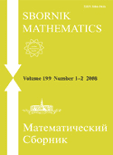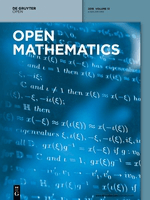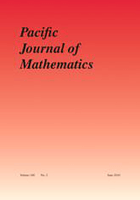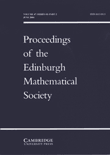
Kyungpook Mathematical Journal
Scope & Guideline
Nurturing the Next Generation of Mathematical Thought Leaders
Introduction
Aims and Scopes
- Algebra and Module Theory:
Focuses on the structure, properties, and applications of algebraic systems, including modules, rings, and algebras, often exploring their interactions and transformations. - Differential Equations and Dynamical Systems:
Covers both ordinary and partial differential equations, including nonlinear dynamics, stability analyses, and applications in various scientific fields. - Functional Analysis and Operator Theory:
Investigates the properties of operators on function spaces, including boundedness, invertibility, and spectral theory, often with applications in quantum mechanics and signal processing. - Geometry and Topology:
Explores geometric structures, topological properties, and their implications in both pure and applied mathematics, including studies of manifolds and metric spaces. - Numerical Analysis and Optimization:
Addresses computational methods for solving mathematical problems, including approximation techniques, numerical stability, and optimization algorithms. - Graph Theory and Combinatorics:
Examines properties of graphs, combinatorial structures, and their applications in computer science and discrete mathematics.
Trending and Emerging
- Nonlinear Analysis and Partial Differential Equations:
An increasing number of publications focus on nonlinear phenomena, particularly involving partial differential equations, reflecting contemporary challenges in modeling real-world systems. - Operator Theory in Banach and Hilbert Spaces:
There is a notable rise in research regarding operators in functional spaces, especially concerning their applications in quantum mechanics and signal processing. - Mathematical Modeling and Simulation:
Papers that explore mathematical models for complex systems, including those in physics, biology, and engineering, are on the rise, showcasing the journal's commitment to interdisciplinary research. - Graph Theory Applications in Network Analysis:
Emerging interest in applying graph theory to solve problems in network analysis, social networks, and computational biology has led to a surge of relevant publications.
Declining or Waning
- Classical Geometry:
Research in traditional geometric topics has decreased, possibly due to the growing interest in more complex geometrical structures and modern applications. - Real Analysis:
Although still relevant, the frequency of papers focusing solely on classical real analysis has diminished, reflecting a potential shift towards more applied or interdisciplinary approaches. - Combinatorial Designs and Block Designs:
Papers specifically addressing combinatorial designs have become less common, indicating a possible transition towards broader combinatorial studies rather than niche topics.
Similar Journals

SBORNIK MATHEMATICS
Unveiling the Depths of Contemporary MathematicsSBORNIK MATHEMATICS is a distinguished journal dedicated to advancing research in the field of mathematics, particularly focusing on areas such as algebra and number theory. Published by the esteemed Steklov Mathematical Institute of the Russian Academy of Sciences, this journal has been a prominent platform for scholarly communication since its inception in 1993 and continues to thrive with contributions of significant relevance through 2024. The journal maintains a Q2 ranking in both the algebra and number theory category as well as in miscellaneous mathematics, highlighting its competitive standing in the mathematical community. While it is not an open-access publication, it offers critical insights and innovative research that are vital for mathematicians, researchers, and students alike. With an ISSN of 1064-5616 and an E-ISSN of 1468-4802, SBORNIK MATHEMATICS serves as a crucial resource for anyone looking to deepen their understanding of contemporary mathematical developments.

Periodica Mathematica Hungarica
Unveiling the Depths of Mathematical Knowledge.Periodica Mathematica Hungarica is a prestigious academic journal published by Springer, focusing on the field of mathematics, with a particular emphasis on miscellaneous mathematical studies. Established in 1971, this journal has maintained its commitment to advancing mathematical research and its applications, making significant contributions over its converged years through 2024. With a Q2 ranking in the mathematics category as of 2023, it establishes itself as a vital resource within the mathematical community. Researchers and academics will find its inclusion in the Scopus database, ranking #189 out of 399 in general mathematics, indicative of its impact and relevance. Although it does not feature open access, the journal provides a wealth of high-quality peer-reviewed articles, thereby serving as an essential platform for the dissemination of innovative mathematical theories, methodologies, and findings. Engaging with the content of Periodica Mathematica Hungarica is crucial for anyone looking to stay at the forefront of mathematical research and development.

Mediterranean Journal of Mathematics
Pioneering New Paths in Mathematics Since 2004The Mediterranean Journal of Mathematics, published by SPRINGER BASEL AG, is a prominent platform dedicated to the advancement of mathematical research and education. Since its inception in 2004, this journal has been pivotal in disseminating high-quality research across various fields of mathematics, currently holding a notable Q2 ranking in the miscellaneous mathematics category as of 2023. With its ISSN 1660-5446 and E-ISSN 1660-5454, the journal enjoys a respected position in the academic community, evident by its Scopus rank of 129 out of 399 in General Mathematics, placing it in the 67th percentile. While primarily a subscription-based journal, it remains committed to providing a comprehensive resource for researchers, professionals, and students, fostering dialogue and exploration within the mathematical sciences. The Mediterranean Journal of Mathematics, based in Basel, Switzerland, continues to contribute significantly to the evolution of mathematical theory and practice, marking its relevance as we approach its 20th anniversary in 2024.

CZECHOSLOVAK MATHEMATICAL JOURNAL
Elevating Understanding through Rigorous InquiryCzechoslovak Mathematical Journal is a distinguished academic journal published by Springer Heidelberg, dedicated to advancing the field of mathematics through the dissemination of high-quality research. With an ISSN of 0011-4642 and E-ISSN 1572-9141, this journal has been a pivotal platform for mathematicians and researchers from around the globe since its inception. The journal holds a Q3 ranking in the field of Mathematics (miscellaneous), demonstrating its commitment to providing a forum for the latest mathematical theories and applications, particularly in general mathematics, as indicated by its Scopus rank of #285/399 and 28th percentile in the field. While currently not offering open access options, the journal continues to attract a wide readership by making its valuable content available through traditional subscription models. The Czechoslovak Mathematical Journal serves as an essential resource for researchers, professionals, and students aiming to stay informed about recent developments and breakthroughs in mathematics, with focus years converging from 1995 to 2024.

Eurasian Mathematical Journal
Innovating Insights, Inspiring Applications.Welcome to the Eurasian Mathematical Journal, a prominent platform dedicated to advancing the field of mathematics, particularly in its miscellaneous applications. Published by the esteemed L N Gumilyov Eurasian National University in Kazakhstan, this journal has been serving the academic community since 2014. With an ISSN of 2077-9879, it has successfully carved its niche within the mathematical landscape, presently ranked Q2 and placing in the 64th percentile among general mathematics publications in Scopus. The journal aims to foster scholarly exchange through high-quality research articles, reviews, and theoretical advancements that enhance understanding and application of mathematical concepts. By prioritizing open accessibility and a rigorous peer-review process, the Eurasian Mathematical Journal contributes significantly to both theoretical exploration and practical innovation, making it an essential resource for researchers, professionals, and students alike.

Open Mathematics
Unlocking Innovative Insights in MathematicsOpen Mathematics, published by DE GRUYTER POLAND SP Z O O, is a prominent peer-reviewed journal that has been a vital platform for disseminating innovative research in the field of mathematics since its inception in 2015. With an impressive impact factor reflected by its Q2 ranking in the miscellaneous mathematics category and a commendable Scopus rank of #91 out of 399, it positions itself as a significant contributor to the mathematical community. This open access journal, headquartered in Poland, welcomes submissions that tackle diverse mathematical theories, applications, and methodologies, fostering knowledge exchange among researchers, professionals, and students globally. Since its launch, Open Mathematics has focused on bridging the gap between theoretical advancement and practical applications, making it an essential resource for anyone seeking to stay at the forefront of mathematical research and innovation. The journal offers easy online access, enhancing the visibility and impact of the valuable work published within its pages.

RICERCHE DI MATEMATICA
Fostering Connections Through Cutting-Edge ResearchRICERCHE DI MATEMATICA, published by SPRINGER-VERLAG ITALIA SRL, is a prominent academic journal situated at the intersection of mathematics and its applications, with an ISSN of 0035-5038 and an E-ISSN of 1827-3491. Based in Italy, this journal serves as a crucial platform for disseminating innovative research findings and theoretical advancements in the diverse fields of applied mathematics and general mathematics, currently ranked in the Q3 quartile as per the 2023 category evaluations. The journal's standing is underlined by its impressive Scopus rankings, securing the 61st position out of 399 in General Mathematics and the 224th in Applied Mathematics, placing it well within the 84th and 64th percentiles respectively. Catering to a global audience of researchers, professionals, and students, RICERCHE DI MATEMATICA not only celebrates mathematical exploration but also enhances understanding through open discourse by fostering connections among scholars from various mathematical disciplines. With a converged publication cycle spanning from 2007 to 2024, the journal is committed to promoting high-quality research that shapes the future of mathematical sciences.

PACIFIC JOURNAL OF MATHEMATICS
Connecting Scholars through Impactful Mathematical ResearchThe PACIFIC JOURNAL OF MATHEMATICS, established in 1951 and published by Mathematical Sciences Publishers, is a premier peer-reviewed journal in the field of mathematics, renowned for its rigorous scholarship and impactful research contributions. With an HIndex that reflects its sustained academic influence, this journal has been categorized within the Q1 quartile in the field of mathematics (miscellaneous) as of 2023, showcasing its position among the top-tier mathematics journals globally. Although the journal operates under a traditional subscription model rather than an Open Access format, it remains dedicated to disseminating original research that spans various domains within mathematics. Researchers, professionals, and students alike will find the journal's breadth of topics and commitment to quality work instrumental in advancing their understanding and exploration of mathematical concepts. This esteemed journal continues to thrive as a vital resource for the mathematical community through its comprehensive collection of articles from a diverse range of mathematical disciplines, thus maintaining a significant role in shaping the future of mathematical inquiry.

PROCEEDINGS OF THE EDINBURGH MATHEMATICAL SOCIETY
Pioneering original research in mathematics.PROCEEDINGS OF THE EDINBURGH MATHEMATICAL SOCIETY, published by Cambridge University Press, stands as a cornerstone within the realm of mathematical research, providing a platform for original papers that push the boundaries of various mathematical disciplines. With a rich history dating back to 1883, this journal has evolved through several converged years, reflecting the dynamic nature of mathematical inquiry. As a Q2 category journal in the field of Mathematics (miscellaneous) according to the latest rankings, it situates itself within the upper tier of academic publications, offering an essential resource for researchers and professionals alike. While it currently does not offer open access options, the journal's contributions are invaluable, facilitating dialogue and collaboration among scholars. The journal's commitment to advancing mathematical knowledge makes it a vital publication for those engaged in the study and application of mathematical theories and principles.

Analele Stiintifice ale Universitatii Ovidius Constanta-Seria Matematica
Advancing Mathematical Frontiers with Open Access InsightAnalele Stiintifice ale Universitatii Ovidius Constanta-Seria Matematica is a prominent open-access journal established by OVIDIUS UNIV PRESS in Romania, dedicated to advancing the fields of mathematics, specifically in Analysis and Applied Mathematics. Since its inception, the journal has emphasized the dissemination of high-quality research, making it accessible to a global audience. With an ISSN of 1224-1784 and E-ISSN 1844-0835, it has positioned itself within the academic community, achieving a respectable Q3 ranking in both analysis and applied mathematics in 2023, reflecting its commitment to rigorous scholarship. The journal spans a considerable publication window from 2009 to 2024, catering to the ongoing developments in mathematical sciences and their applications. Researchers, professionals, and students alike will find valuable insights and contributions that enrich their understanding and foster collaboration within the mathematical community. The journal's headquarters is based at the Faculty of Mathematics & Computer Science, Bulevardul Mamaia 124, Constanta, Romania.